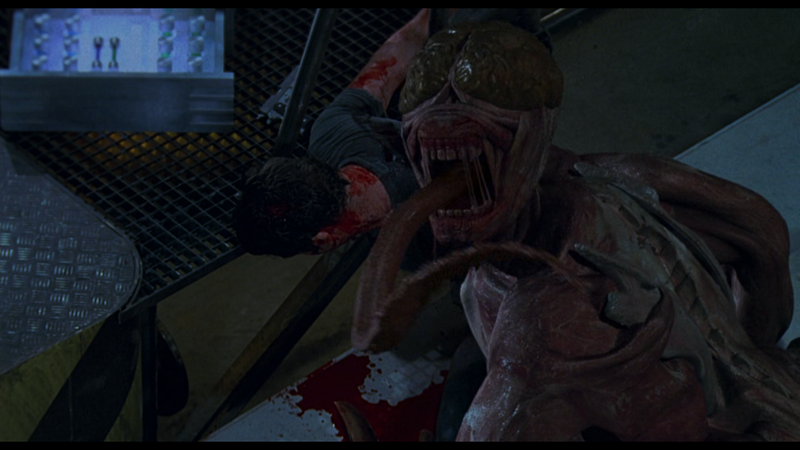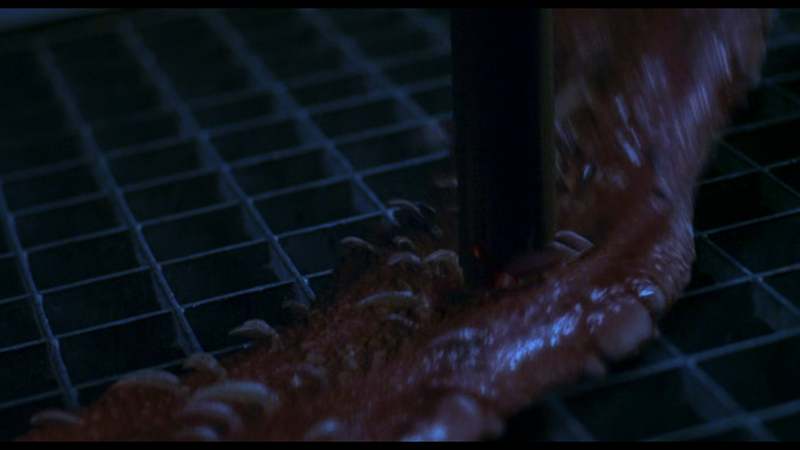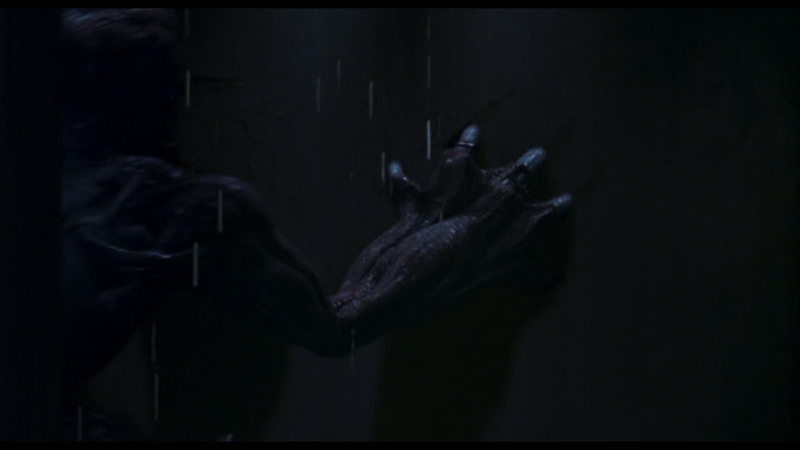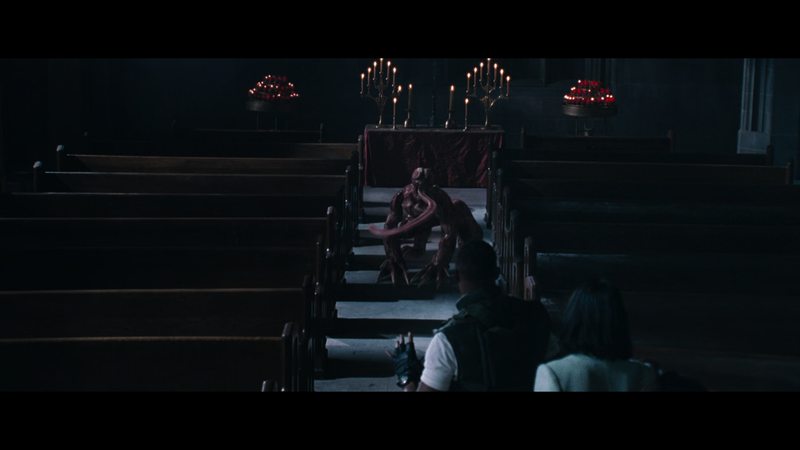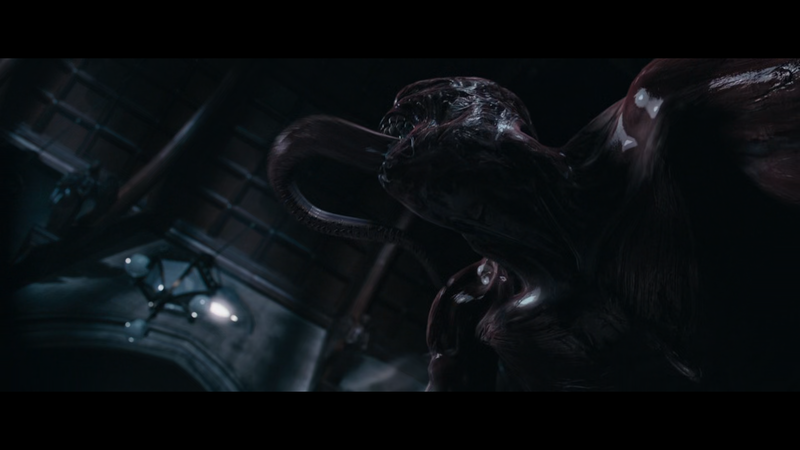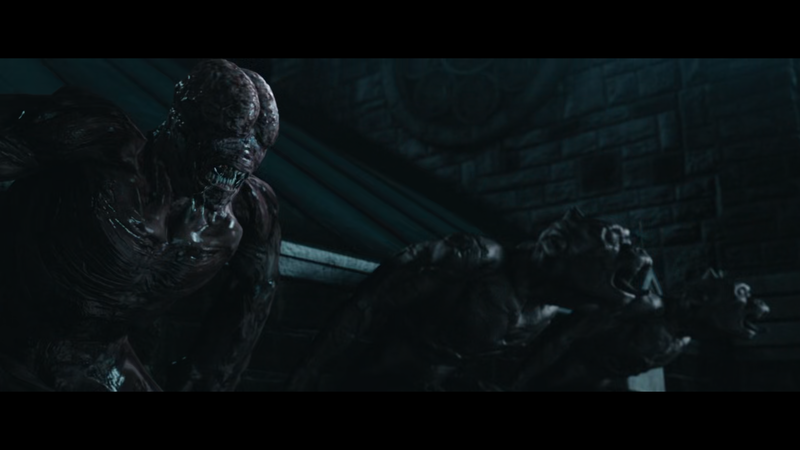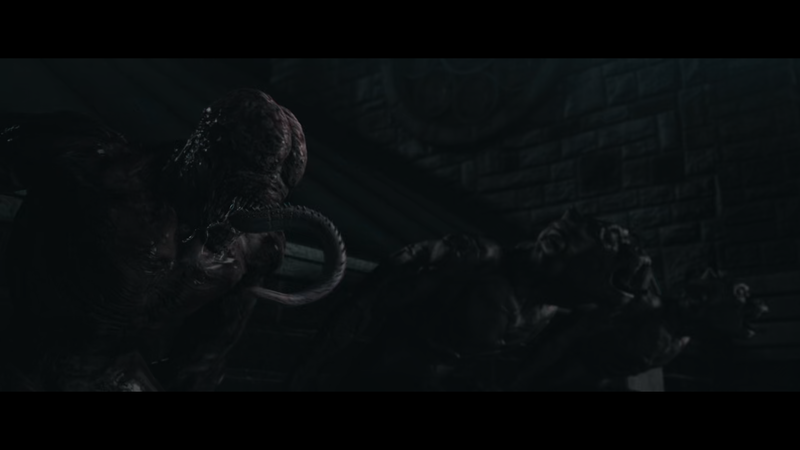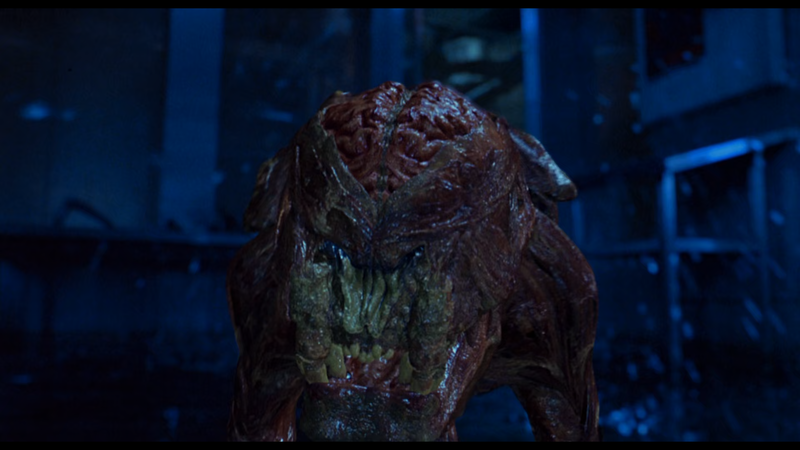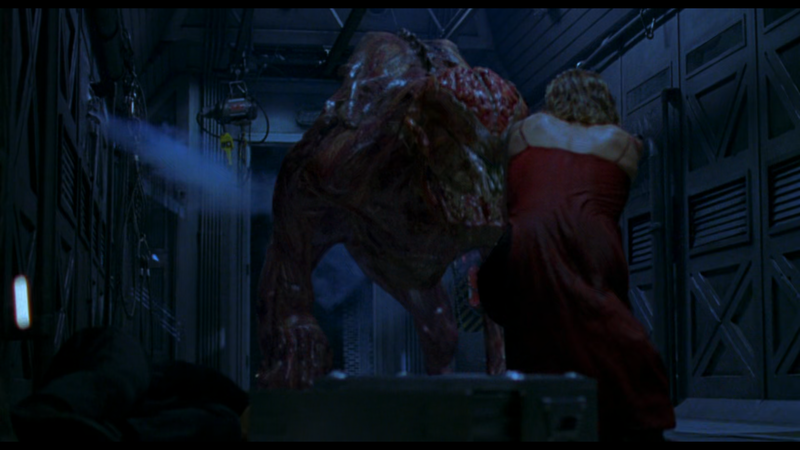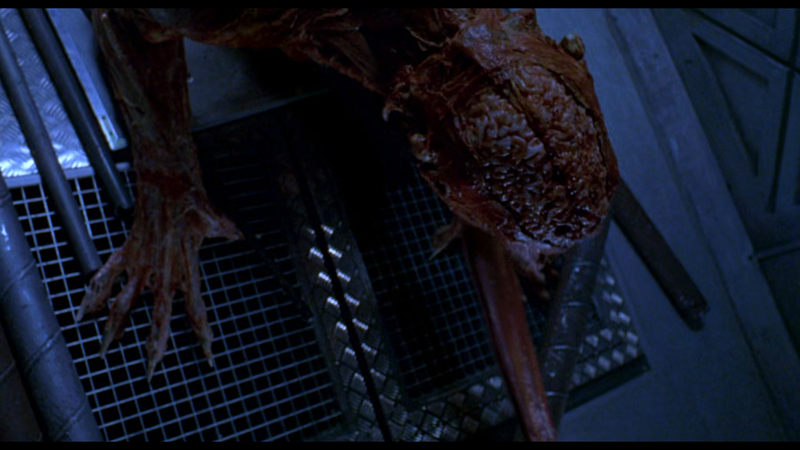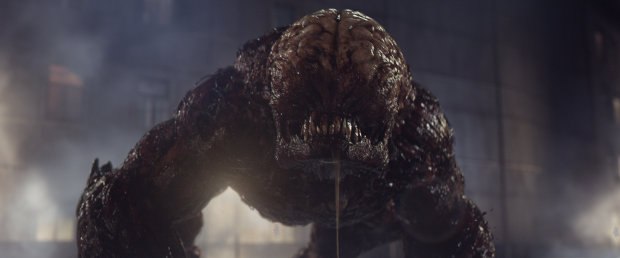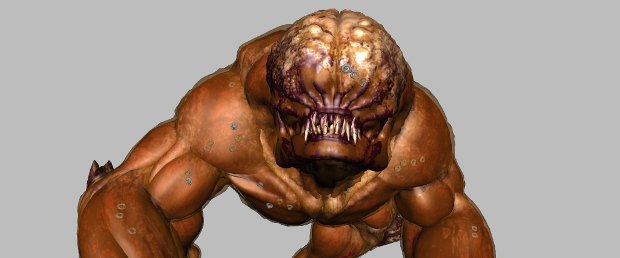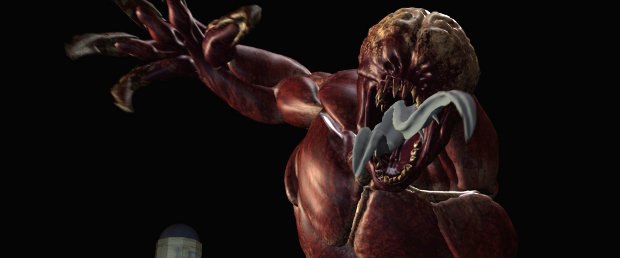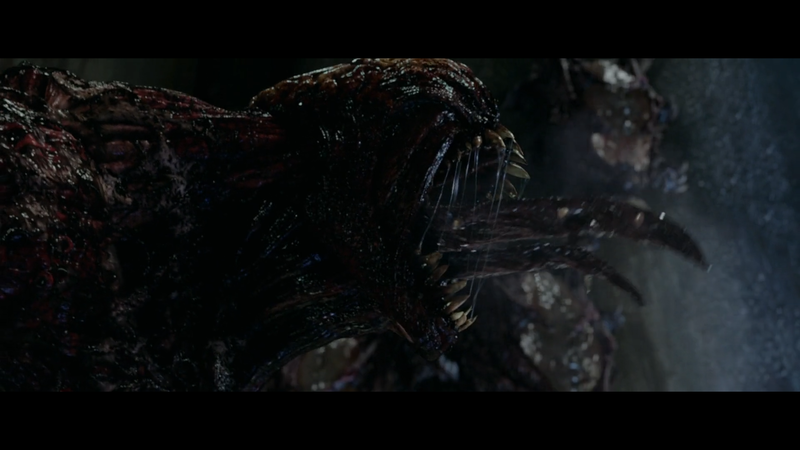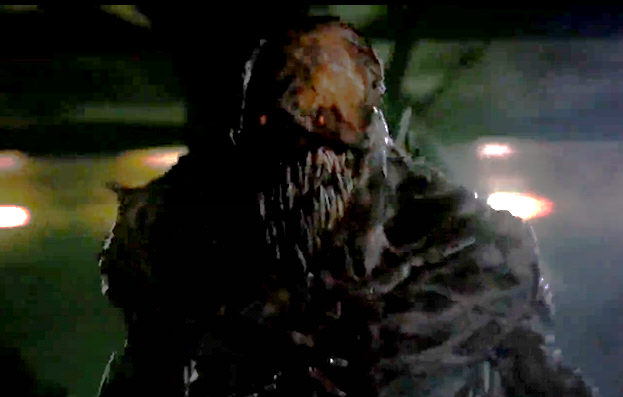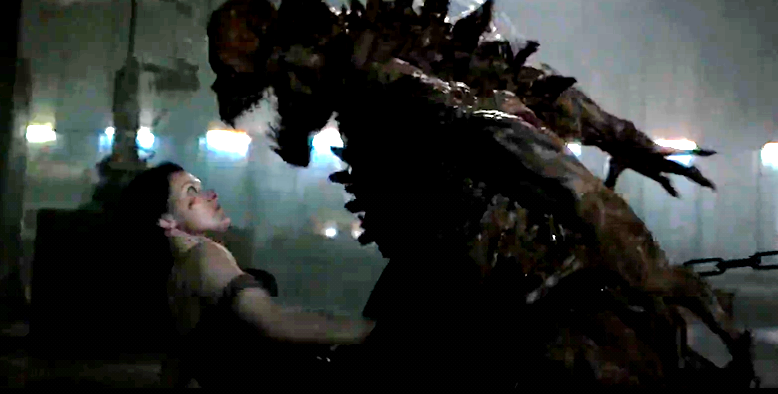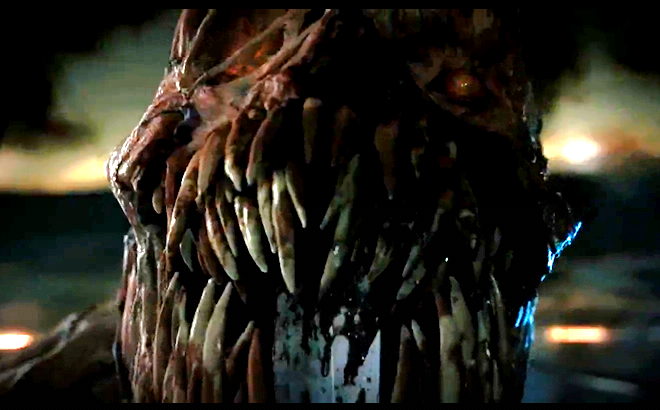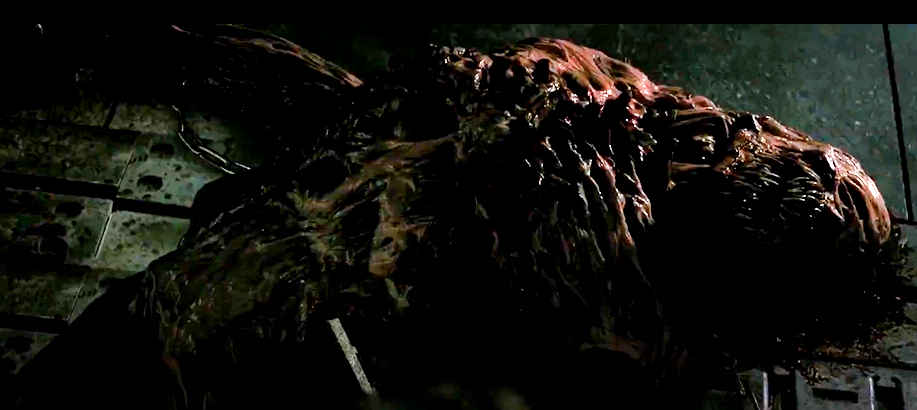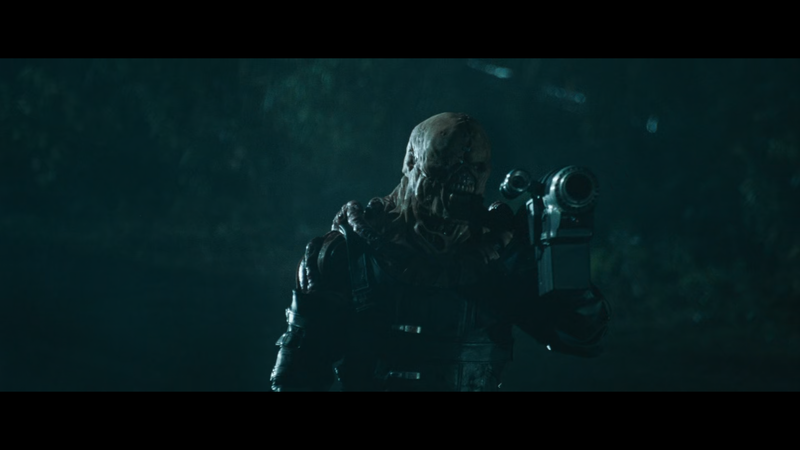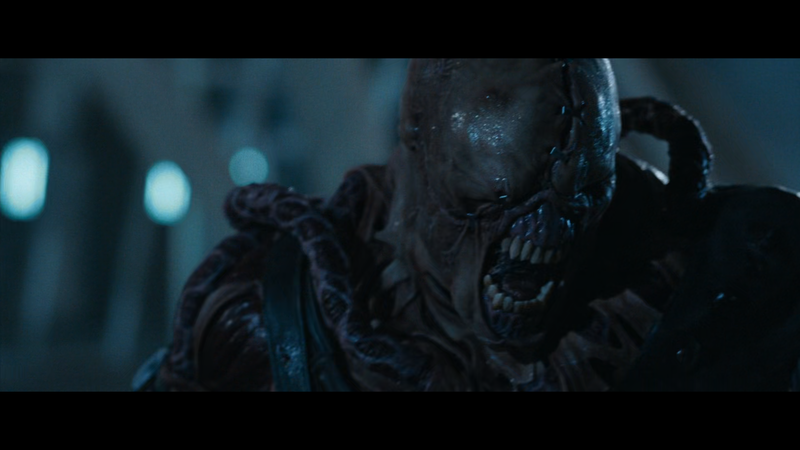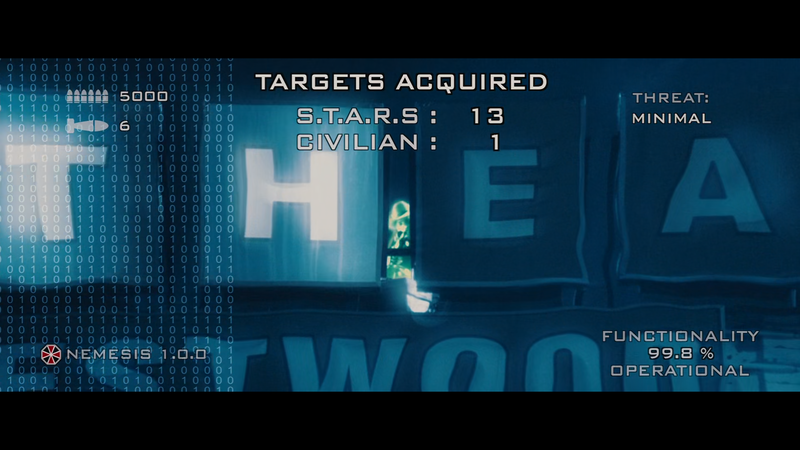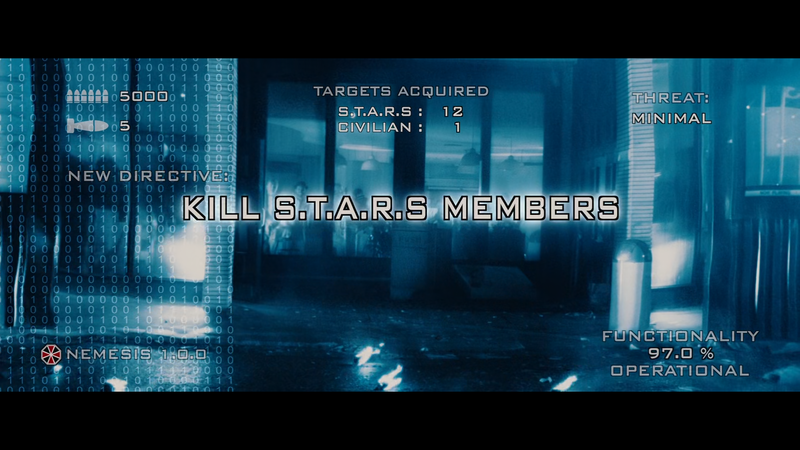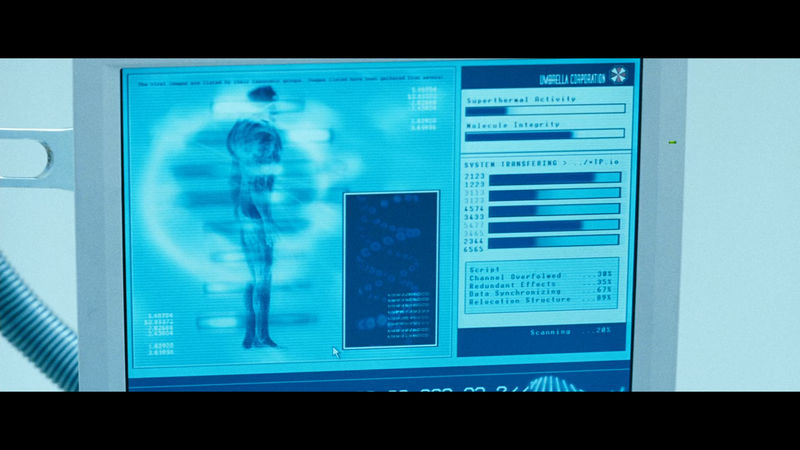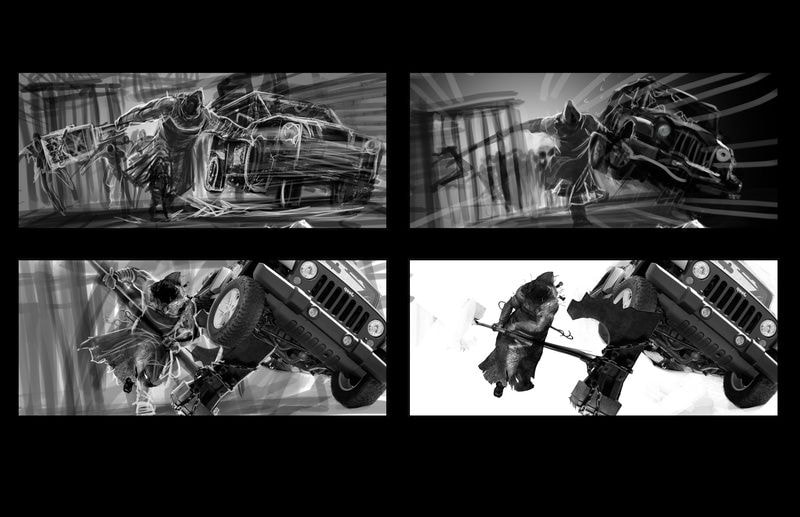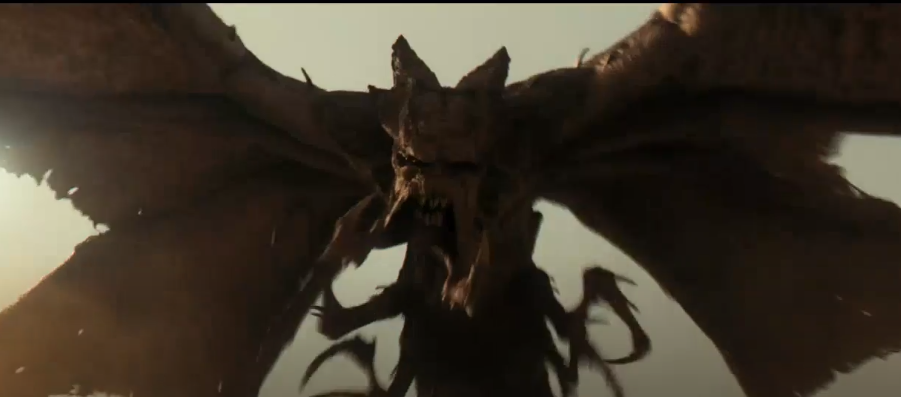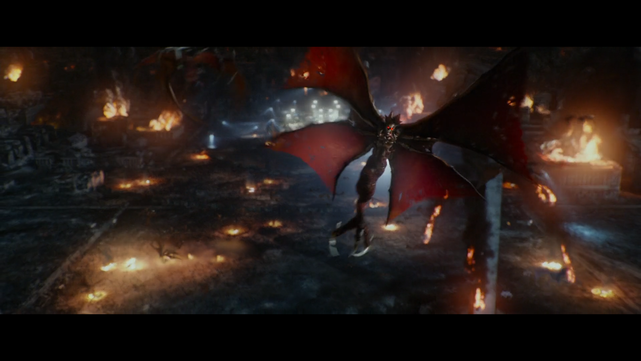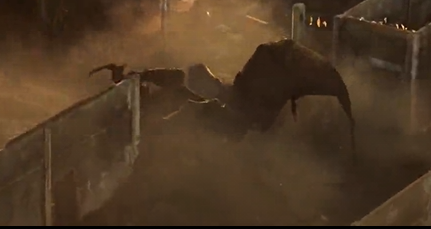The T-virus was a bioweapon developed by the Umbrella Corporation; it was “a weapon of mass destruction beyond any world leader's wildest dreams—or nightmares” and was the deadliest virus ever developed by man. Its release into the world lead to the deaths of over 7 billion people, nearly wiping out the human race, and replaced them with relentless Undead creatures. The T-virus and Las Plagas covered here are from the live-action films directed by Paul Anderson and are not to be confused with their identically named game counterparts, which are covered in Virus Analysis: Tyrant and Virus Analysis: Las Plagas. This Analysis also covers the Scarab device, despite it having no stated relationship to any virus or parasite, as it is a direct adaption of the P30 drug from Resident Evil 5, which is based on the Progenitor Virus. Alexander Isaacs is also covered, despite his enhancements being technological rather than biological.
The information making up this analysis is a combination of info from the movies, their screenplays, and their novelizations, in addition to commentaries, featurettes, interviews, press kits, and other supplements. Special thanks to Rodney Holbrook, BSAArklay, Forerunner from the Resident Evil Wiki, Dr. Wunderbar, and Reen Hearst for contributing to this analysis in various ways.
The information within this analysis can be found in the following sections:
Part 1
1. History
2. T-virus Effects
3. T-virus Parasite Theory
4. Anti-Virus
5. Undead 6. Undead Dogs
7. Undead Crows
Part 2
Bioweapons and Other Monsters
Part 3
1. Evolved Humans 2. Las Plagas 3. Scarab 4. Sources and Note on Canon
This is part two only of Virus Analysis: Anderson.
The information making up this analysis is a combination of info from the movies, their screenplays, and their novelizations, in addition to commentaries, featurettes, interviews, press kits, and other supplements. Special thanks to Rodney Holbrook, BSAArklay, Forerunner from the Resident Evil Wiki, Dr. Wunderbar, and Reen Hearst for contributing to this analysis in various ways.
The information within this analysis can be found in the following sections:
Part 1
1. History
2. T-virus Effects
3. T-virus Parasite Theory
4. Anti-Virus
5. Undead 6. Undead Dogs
7. Undead Crows
Part 2
Bioweapons and Other Monsters
Part 3
1. Evolved Humans 2. Las Plagas 3. Scarab 4. Sources and Note on Canon
This is part two only of Virus Analysis: Anderson.
Besides turning humans and animals into Undead the T-Virus could also create even more ferocious creatures - usually by injecting the base strain of the virus (its “primary form”) into a living host and through the use of additional genetic modifications. This was seemingly the largest improvement made to the Progenitor Cell when it was used to create the T-virus. These creatures are here called “live hosts”, in contrast to Undead which were created by an airborne or transdermal strain (“secondary form” of the virus). Live hosts were also referred to as “mutations” (The Final Chapter novelization). Umbrella employees also referred to both live hosts and Undead as “biohazards” following the leak of the virus into the world.
Most live hosts were created by the Umbrella Corporation for use as bio-mechanical weapons at facilities such as the Hive and Umbrella Prime. While the primary purpose of the T-virus was to cause enemy soldiers to turn against each other (Undead), wiping out populations while leaving infrastructure intact, it was also used to create intelligent, near-immortal soldiers that could be used as a replacement for humans on the battlefield.
Umbrella seemingly intentionally released many live hosts into the world once the T-Virus pandemic began in order to speed up the downfall of humanity. Umbrella also continued experiments on the T-virus after the apocalypse happened, using both clones and survivors captured by the Arcadia as test subjects. This led to the development of new, more advanced types of bioweapons, which were subsequently released as well.
Most live hosts were created by the Umbrella Corporation for use as bio-mechanical weapons at facilities such as the Hive and Umbrella Prime. While the primary purpose of the T-virus was to cause enemy soldiers to turn against each other (Undead), wiping out populations while leaving infrastructure intact, it was also used to create intelligent, near-immortal soldiers that could be used as a replacement for humans on the battlefield.
Umbrella seemingly intentionally released many live hosts into the world once the T-Virus pandemic began in order to speed up the downfall of humanity. Umbrella also continued experiments on the T-virus after the apocalypse happened, using both clones and survivors captured by the Arcadia as test subjects. This led to the development of new, more advanced types of bioweapons, which were subsequently released as well.
Live hosts could be seen as new animals, created using the evolutionary effects of the T-virus. They did not seem to discriminate as much in what they did and did not attack, unlike Undead which usually avoided attacking those already infected with the virus. This is likely due to the fact that while Undead relied totally on instinct live hosts had the intelligence to deliberate and make their own decisions. While they typically preferred living flesh to feed on there have been multiple instances of them attacking both Undead and each other, which could be attributed to new mutations influencing their behavior. Mutations of the same “type” would generally leave each other alone or even cooperate.
Cages used to contain live hosts at the Hive were smeared with feces and urine (The Final Chapter novelization), which indicates that their digestive systems were still active – this would mean live hosts may have needed bodily systems other than the brain in order to survive, which technically made them more vulnerable than Undead. But the enhanced abilities and regenerative potential of live hosts more than made up for this potential weakness. The additional energy granted by having these systems active would also make them deadlier fighters.
When Raccoon City was nuked many live hosts and other mutations fled into the Hive to escape the heat from the fires and radiation. They then formed their own unique underground ecosystem for the ten years they remained active there. They would leave the Hive at times to search for more food, but most returned to it, seeing it as a safe habitat (The Final Chapter novelization).
Cages used to contain live hosts at the Hive were smeared with feces and urine (The Final Chapter novelization), which indicates that their digestive systems were still active – this would mean live hosts may have needed bodily systems other than the brain in order to survive, which technically made them more vulnerable than Undead. But the enhanced abilities and regenerative potential of live hosts more than made up for this potential weakness. The additional energy granted by having these systems active would also make them deadlier fighters.
When Raccoon City was nuked many live hosts and other mutations fled into the Hive to escape the heat from the fires and radiation. They then formed their own unique underground ecosystem for the ten years they remained active there. They would leave the Hive at times to search for more food, but most returned to it, seeing it as a safe habitat (The Final Chapter novelization).
Lickers were early bio-mechanical weapons created by Umbrella at the Hive facility and later released into Raccoon City. Lickers were also reproduced in the Umbrella Prime Facility and used as weapons against the last remaining human settlements during the apocalypse, such as the White House fortress (Retribution screenplay and novelization, The Final Chapter novelization).
The middle image was scanned from the Biohazard 2 Movie Data File by RELive. The left image is the Licker as seen in the first film, while the right image is a Licker from Apocalypse.
A Licker was the result of a live human being injected with the T-virus. The Retribution novelization claims that they were created with an alternative strain, although the validity of this is debatable. The excessive regeneration caused by the virus both strengthened the Licker body without killing the host while also causing abnormal tissue development. It is implied that the creation of Lickers also involved other genetic modifications, and so their attributes were not entirely the result of “natural” infection. While Undead lacked living cells with ATP to allow for sufficient augmentations, Lickers were entirely comprised of living cells and so were more easily modified. Besides giving Lickers traits that made them efficient bioweapons, Umbrella also managed to create even more powerful variants (see “Uber Licker” below).
Excessive activity in the cells of the brain, muscles, and bones caused Lickers to have exaggerated traits in these areas, to their benefit and detriment. Their muscles would expand to the point that they would rip through the skin. This caused the entire body of the host to be flayed. The brain was swollen and would expand to the point that it emerged from the skull, with the eyeballs destroyed to make room (this is similar and likely related to how the virus causes the pineal gland in Undead brains to expand). Licker spines were overdeveloped into a bent position, forcing them to walk on all fours. The bones on the limbs were bent in directions suitable for quadrupedal movement. The bones would also grow to the point they emerged from various parts of a Licker’s body, including from the tips of the fingers, creating large claws.
The Licker tongue muscle would grow most of all. The tongue extended from a Licker’s square jaw like a snake, giving the Licker its name. A Licker’s tongue was covered in thousands of tiny, razor-sharp barbs alongside the sides, making whip attacks from the tongue especially dangerous. Lickers would also use their tongues to strangle prey or pull them in from a distance like a fishing line.
Lickers also developed a set of canine-like fangs, likely to help grip prey and tear flesh when eating. The rest of the teeth would vary in shape and could be anything from almost human to completely jagged. Like Undead, Licker breath was described as “wretched”.
As Lickers were not undead, they had a heat signature, would breathe, and could feel pain to some degree.
A Licker weighed around 300 pounds (according to the screenplay for the first film) and had strength far beyond what would be considered possible in a normal animal. Their claws were strong enough to dig into rock and punch through metal; and they were durable enough to withstand many gunshot wounds, including a direct hit from a shotgun. Their unique musculature allowed them to dash with lightning speed, similar to the small bursts of speed displayed by Albert Wesker. They could scale walls and ceilings with the ease of a spider. Their jumping abilities and agility were also impressive. Lickers could even swim (Retribution novelization).
Lickers were among the earliest T-Virus bioweapon experiments, and so while formidable they were also burdened with faults and were considered unstable by Umbrella.
Licker intelligence is debatable. It may be their mental capacities were reduced, despite brain growth (suggesting this brain growth was largely useless - it is sometimes described as mere “swelling”). Swelling and/or overdevelopment of certain sections of the brain may put pressure on and harm the parts of the brain responsible for higher reasoning and memory. This could also actually have been the result of Umbrella purposefully diminishing Licker intelligence in order to make them more susceptible to control.
Alternatively, Lickers may have been no less intelligent than humans altogether, or the drop in intelligence was relatively minimal. According to the Retribution novelization:
Lickers appeared to be the embodiment of murderous rage, and nothing more. But they had been human beings once, and retained human cunning. There was an evil hibernating in the human brain, and it could be fanned by genetic engineering, she knew. It could be spurred into wakefulness, an insect inside that could take over the mind and make its monstrous appetites, its rapacity, the center of all meaning. Lickers weren't just mutations, they were the personification of the most primeval impulses in humanity, the animal within the animal.
The idea that the animalistic behavior of Lickers is not due to a loss in intelligence but rather a prioritization of inner, primal instincts and evil thoughts is supported by the Red Queen in the original movie screenplay, where she attributes the Undead cravings for human flesh to the same phenomenon.
Regardless, Lickers did retain a fair amount of intelligence. Lickers often used stealth and ambush tactics. They displayed somewhat sadistic behavior, toying with prey in a church prior to attacking. They were very social and traveled exclusively in packs. They also recognized guns as dangerous and not only avoided gunfire but would actually use their tongues to disarm prey. This is not only attributed to intelligence but to them having good survival instincts (like other live hosts such as Alice or Nemesis). Lickers would often growl and screech, and it is implied they may have used these sounds as a form of communication with other Lickers. In particular, Lickers have been shown to “call out” to others of their own kind, especially when injured or dying (Retribution screenplay). They were also capable of anger and frustration.
Regardless, Lickers did retain a fair amount of intelligence. Lickers often used stealth and ambush tactics. They displayed somewhat sadistic behavior, toying with prey in a church prior to attacking. They were very social and traveled exclusively in packs. They also recognized guns as dangerous and not only avoided gunfire but would actually use their tongues to disarm prey. This is not only attributed to intelligence but to them having good survival instincts (like other live hosts such as Alice or Nemesis). Lickers would often growl and screech, and it is implied they may have used these sounds as a form of communication with other Lickers. In particular, Lickers have been shown to “call out” to others of their own kind, especially when injured or dying (Retribution screenplay). They were also capable of anger and frustration.
|
Lickers were also completely blind due to lacking eyes. They would compensate for this through their evolved sense of smell. In the original screenplay for the first movie, the Licker enhanced its awareness of its surroundings by swinging its tongue to sense the air. A Licker was also said to use its tongue this way in the Retribution screenplay. In Apocalypse the “visual” point-of-view of a Licker was shown, suggesting their other senses were so great as to fully compensate for the loss of sight. Licker “vision” was tinged red.
Like Nemesis, Lickers may have been able to detect the temperature of prey, allowing them to pick out live hosts. This is supported by Licker “vision” seeing humans as glowing. A Licker was also able to track survivors through the exact route they took in the Hive, which could have been the result of a heightened sense of smell. Licker “vision” could actually be gained from psionic powers, a result of their expanded brain development. According to the novelization for The Final Chapter Lickers hunted by sound. This made it difficult for them to maneuver themselves when they were present in a loud battlefield. |
Bites or scratches from a Licker would spread the virus, like those of the Undead. But it is unknown if victims of Lickers would become Undead or a live mutation like the Lickers themselves. The only known individual shown infected by a Licker was Matt Addison, whose unique DNA made him an extraordinary case and not a reliable example for what would be a typical result of Licker infection.
In the first movie’s original screenplay the Licker was said to have some human internal organs remaining, while other organs were altered to the point of becoming unrecognizable. Licker blood was said to be a dark, oily ooze (perhaps implying coagulation). Also, in the screenplay the Licker had an armored hide and multiple rows of shark-like teeth (the latter of which was also described in the Retribution screenplay). Instead of being the result of live infection, the screenplay simply said Lickers were made by using the “same genetic material as the T-Virus".
In the novelization for the first movie the Licker still had skin, but it was more comparable to that of a rhinoceros than that of a human. Its scaly, brown and red skin was said to be platted and faceted/corded. Expanded bones would stick out amidst the skin, which were very horn-like. The appearance of its skin and horn-like bones may suggest Umbrella spliced rhino DNA into the Licker to enhance its combat abilities. This is supported by Umbrella’s other hybridization experiments at Hive, which involved fusing the DNA of various animals.
In the sequel novel (Apocalypse) the rhino skin discrepancy was solved. It was specified that the exposed muscle tissue was simply hardened to the point it resembled the leathery skin of rhinos. This hardening would provide a Licker with extra defense against a weapon’s fire.
In the novelization for the first movie the Licker still had skin, but it was more comparable to that of a rhinoceros than that of a human. Its scaly, brown and red skin was said to be platted and faceted/corded. Expanded bones would stick out amidst the skin, which were very horn-like. The appearance of its skin and horn-like bones may suggest Umbrella spliced rhino DNA into the Licker to enhance its combat abilities. This is supported by Umbrella’s other hybridization experiments at Hive, which involved fusing the DNA of various animals.
In the sequel novel (Apocalypse) the rhino skin discrepancy was solved. It was specified that the exposed muscle tissue was simply hardened to the point it resembled the leathery skin of rhinos. This hardening would provide a Licker with extra defense against a weapon’s fire.
Lickers, like Undead, were driven by hunger and fed on human prey. It is unknown if Lickers actually needed to feed to survive or if they only did so out of instinct and cruelty, like Undead. If they did require sustenance, it would be due to their bodies being more intact and relying on more traditional means of acquiring nutrition.
After feeding, a Licker would sometimes mutate due to consuming “fresh DNA”. A fed Licker would become a “Super Licker” (tentative), which according to the Red Queen was “a stronger, faster hunter." The reasons for this are speculated in the “Effects” section in part 1 of this analysis, and this may be a factor in why they fed on uninfected flesh in the first place. This mutation could actually have been more like a natural maturation in Licker development, like how Undead may transform into Majini Undead after feeding on enough uninfected flesh.
The progressive transformation of a Licker into a Super Licker
A Licker that fed on Spence at the Hive mutated into one such Super Licker. Its muscles and bones expanded further, perhaps due to obtaining more biomass from its food. Its muscles turned a darker coloration. Its head became more angular, its claws expanded, and its torso lengthened. Its hind legs became similar to those found on natural quadrupeds, making it a faster runner. Its teeth mutated heavily, with not only the fangs enlarging but the rest of the teeth developing sharp ends and the mouth cavity enlarging on both of its ends. The Super Licker was generally feline-like, and it became more and more bestial as its transformation accelerated. This combined with Licker and Undead behavior being primal and bestial seems to imply the T-virus caused those who do not adapt to revert into primitive animals. This is supported by the above quote from the Retribution novel.
The Super Licker was so durable that it was even able to survive gunshot wounds to its exposed brain, and it wasn’t killed until its body was incinerated by the friction caused by being dragged by a speeding tram car.
The Super Licker was so durable that it was even able to survive gunshot wounds to its exposed brain, and it wasn’t killed until its body was incinerated by the friction caused by being dragged by a speeding tram car.
The Uber-Licker (sometimes spelled using a hyphen, sometimes using a space) was an experimental, improved version of regular Lickers created at Umbrella Prime, possibly as a continuation of the Licker project started at the Hive. A single specimen was released by Umbrella to destroy Leon’s strike team, which proceeded to stalk them and Alice. It was eventually destroyed by a belt of incendiary grenades. While more Uber-Lickers were released, they did not manage to reach the group before the facility was destroyed. Later on, multiple other Uber-Lickers were among the Undead hordes that besieged the White House. These Lickers merged with the Melange bioweapon (The Final Chapter novelization).
Uber-Lickers were most distinguishable by their enormous size – 12 yards long from head to tail, with the heft of a “fairly squat elephant” (Retribution novelization). They would very noticeable drool uncontrollably and had visible breath (perhaps due to them being cryogenically stored prior to their being unleashed, or due to some biological mechanism that cooled their bodies). Along with their increase in size came enhanced strength and durability. They easily knocked over cars, broke through concrete, and killed or incapacitated humans with a single swipe of their hands, each of which was the size of an adult human. A bite from an Uber-Licker's massive jaw was strong enough to tear a person in half. They were heavy enough to crush cars, crack pavement, and flatten anyone unlucky enough to be in the way when they ran.
Uber-Lickers had two tongues which helped them subdue and maintain an unbreakable grip on prey. The barbs on the sides of these tongues were not as numerous as the ones on normal Licker tongues, but they were far larger. The ends of the tongues were also tipped with claw-like hooks.
Uber-Lickers had two tongues which helped them subdue and maintain an unbreakable grip on prey. The barbs on the sides of these tongues were not as numerous as the ones on normal Licker tongues, but they were far larger. The ends of the tongues were also tipped with claw-like hooks.
Gunfire was only an irritant to an Uber-Licker and even being buried under tons of metal girders and stone only served to slow them down. When Alice shot an Uber-Licker multiple times in the brain at point-blank range, piercing it, it only served to knock the Licker unconscious for several minutes. Even after temporarily regaining her powers Alice was not sure she could take on an Uber-Licker singlehandedly, as she noted they were “almost impossible to kill” (The Final Chapter novelization).
Due to both their enhanced musculature and long leg strides Uber-Lickers were incredibly fast. One was able to catch up to a car going 70 miles per hour, running “like a race horse”. They were also surprisingly agile; one flipped itself upright while falling from a ceiling (Retribution novelization).
Due to both their enhanced musculature and long leg strides Uber-Lickers were incredibly fast. One was able to catch up to a car going 70 miles per hour, running “like a race horse”. They were also surprisingly agile; one flipped itself upright while falling from a ceiling (Retribution novelization).
Curiously, an Uber-Licker would often capture prey instead of outright killing them and place them alive inside cocoons. An Uber-Licker would use these cocoons to preserve their food - like a spider wrapping its prey for later consumption. The Lickers would also use trapped humans, who were left awake and thrashing in an attempt to escape, their voices only partially muffled, to lure other humans within grabbing distance of the Uber-Licker’s tongues. The central sack of an Uber-Licker cocoon, which held the victim, was made of an “embryonic” membrane the Licker formed from a webbing it excreted from its mouth (the drool of an Uber-Licker may actually have been this webbing), while the surrounding section holding it to surfaces was made of bone and skin (the source of which is unknown).
A cocoon could be formed in mere minutes but could be pierced from the outside with some effort. Those trapped within a cocoon were unable to break free due to the webbing constraining the limbs enough to prevent full movement. Surrounding the sides of a cocoon were “arms” or fingers tipped with single claws. When a person approached an occupied cocoon, these claws were supposed to close like a beartrap and kill the approaching person and occupant before they could escape. As this idea was not shown when Alice rescued Becky, it may have been a scrapped idea, with the arms simply being cosmetic.
While a cocoon was supposed to keep live humans trapped in order to keep them fresh for later consumption, some cocoons housed corpses as well. It may be the occupants of these cocoons were mortally wounded prior their being cocooned and they simply succumbed to their injuries while within them. It may also be that a cocoon was able to preserve corpses as well.
A cocoon could be formed in mere minutes but could be pierced from the outside with some effort. Those trapped within a cocoon were unable to break free due to the webbing constraining the limbs enough to prevent full movement. Surrounding the sides of a cocoon were “arms” or fingers tipped with single claws. When a person approached an occupied cocoon, these claws were supposed to close like a beartrap and kill the approaching person and occupant before they could escape. As this idea was not shown when Alice rescued Becky, it may have been a scrapped idea, with the arms simply being cosmetic.
While a cocoon was supposed to keep live humans trapped in order to keep them fresh for later consumption, some cocoons housed corpses as well. It may be the occupants of these cocoons were mortally wounded prior their being cocooned and they simply succumbed to their injuries while within them. It may also be that a cocoon was able to preserve corpses as well.
In a screenplay for Retribution, Uber-Lickers also possessed the ability to spew an acidic bile at prey. They used this not only as a form of attack but also to dissolve the flesh of prey in “preparation for consumption”. The use of digestive juices outside of the body is practiced by flies as well. This bile was capable of eating through skin, clothing, and even combat armor. When used on Barry Burton, it gave him near-lethal burns and left him half blind.
Aside from their size, durability, two tongues, and the ability to create cocoons, Uber-Lickers were mostly identical to normal ones, aside from having slightly darker muscle tissue and a deeper voice. Umbrella simply modified the base Lickers to enhance their abilities further. They displayed the same human-like intelligence, cunning, capacity for self-preservation, tracking and climbing skills, and stealth. They were just as social as normal Lickers and cooperated not only with each other but with their smaller brethren as well (Retribution screenplay). A solitary Uber-Licker would often find a high place to roost from, with cocoons nearby to act as bait for other humans. When a human was within range it took advantage of its strength and size to grab its prey with its tongue and lift them into its mouth, at which point it would calmly chew them to death. An Uber-Licker that singled out Alice as being particularly dangerous used the child Becky as such bait to lure Alice into a trap. The planning displayed here, as well as its ability to pick up on Alice’s attachment to the girl, is the most prime example of Licker intelligence and cunning (the Retribution novelization explains that this intelligence is possessed by all Lickers). Uber-Lickers could also hold a human-like vendetta against those who harmed it, with one (supposedly) planning on torturing Alice for days before killing her (Retribution novelization).
In the Retribution novelization Uber-Lickers were described as being pink instead of dark red. They only had a single tongue in this depiction, which was only the width of a power cable but even longer (able to stretch down from near the top of the 300-foot-high ceiling of the Moscow simulation). This tongue was also strong enough to grip with enough force to crack human ribs. Their exposed brains were described as both leathery and fungus-like, and they noticeably pulsed. Like the normal Licker in the original screenplay for the first movie, it sensed its way forward by using its extended tongue. The barrage of bullets Alice unleashed on the Uber-Licker's brain killed it in the novel, and she was pursued after this by more Uber-Lickers instead.
Uber-Lickers were described as reacting to sources of light in the Retribution novelization. Some animals are able to detect light and even “see” without the use of eyeballs. They accomplish this using light-sensitive cells and proteins. Uber-Lickers may have such cells implanted along the surface of their bodies or along the tongue. This ability could even apply to regular Lickers and would explain the “Licker vision” from the Apocalypse movie.
Uber-Lickers are also described as having been “experimental” in the Retribution novel. Leon and Barry both remarked that they had never seen a Licker that big, meaning they were newly created and perhaps not yet unleashed on the world. Jill described them as lacking proper control measures due to this, making them just as likely to kill Umbrella allies as they were to kill Umbrella’s enemies. An Uber-Licker went so far as to intentionally bite Las Plagas Undead due to it having been enraged by Alice. When not angered Uber-Lickers seemed to either cooperate with or outright ignore Las Plagas Undead (Retribution screenplay), likely due to them not seeing them as a desirable source of food.
In the novelization for The Final Chapter two of the Uber-Lickers invading the White House grounds were described as being different sizes, with one reaching a length of 50 feet (14 feet longer than the Uber-Licker from Retribution) and with the other being even larger. The varying sizes of Uber-Lickers could indicate age; they could also be alternative types, or they could even just be the result of different hosts reacting differently to Umbrella’s modifications.
The name “Uber Licker” comes from the commentaries and featurettes for Retribution. “Über” is German for “Over” or “Above” and is typically used as a prefix to describe something as being a superior type.
The Bloodshot was a creature confronted by Alice Abernathy during her return trip through the ruins of the Hive in 2012. The exact origins of this creature are unknown, although there is enough evidence to narrow down the potential explanations for it.
The Bloodshot stalked Alice in the “Disassembly Room”: an area used by Umbrella to dismember and dispose of failed test subjects (The Final Chapter novelization). Despite this, the Bloodshot was displayed on a monitor and labeled as being a part of the Hive’s security system, making it seem to be a bioweapon, not a failed test subject that escaped. In the novel Alice also says that it was “a bioweapon, infected with massive amounts of the T-virus", while in the movie she said it was simply a bioweapon that used to be human. Alternatively, if the Bloodshot was a failed test subject after all or one of the many wild mutations living in the abandoned sections of the Hive, it may be that it was implanted with an avatar implant (and/or other cybernetics) sometime prior the events of The Final Chapter and used as a sort of makeshift security measure. In the novelization countless bones were scattered across the floor, picked clean of meat. This could imply that the Bloodshot was feeding on the old corpses in the Disassembly Room or bringing recent prey into the room, which had become its lair. Many of the bones were those of monsters, implying the Bloodshot was among those monsters in the Hive that were said to prey on other mutations.
The Bloodshot was very clearly Licker-like in that it was skinned and had its brain exposed. This, combined with the above information, could imply it was:
1. An offshoot of the Licker Program that was never mass produced due to the outbreak at the Hive, with the only specimen being used as a security instead.
2. A Licker that mutated - over time or after consuming fresh DNA (the latter would make it a type of Super Licker). The radiation created by the nuke that hit Raccoon City could have induced or amplified further mutations. It may have formerly been one of the Lickers released into Raccoon City, which fled back to the Hive when the bomb hit the city. It would afterwards be implanted with control devices by Umbrella; or it was simply monitored by them and listed as being part of their security measures since it was guarding the area by happenstance.
3. A test subject in the Licker Program that experienced unique mutations which was meant to be disposed of. Any potential implants it may have had could have been a part of its initial experimentation or something Umbrella implanted into it at a later date.
1. An offshoot of the Licker Program that was never mass produced due to the outbreak at the Hive, with the only specimen being used as a security instead.
2. A Licker that mutated - over time or after consuming fresh DNA (the latter would make it a type of Super Licker). The radiation created by the nuke that hit Raccoon City could have induced or amplified further mutations. It may have formerly been one of the Lickers released into Raccoon City, which fled back to the Hive when the bomb hit the city. It would afterwards be implanted with control devices by Umbrella; or it was simply monitored by them and listed as being part of their security measures since it was guarding the area by happenstance.
3. A test subject in the Licker Program that experienced unique mutations which was meant to be disposed of. Any potential implants it may have had could have been a part of its initial experimentation or something Umbrella implanted into it at a later date.
Despite generally looking like a Licker the Bloodshot also had some very different features. Most noticeably the Bloodshot’s bones were not nearly as twisted, allowing it to stand upright on two legs. Its claws were smaller than those of a Licker but still sharp enough to penetrate body armor (The Final Chapter novelization). Its claws were attached to elongated fingers. It lacked a long tongue but retained its eyes, which were clear and bright red (hence its name).
While the Bloodshot’s skeletal structure remained relatively humanoid it was still significantly altered. Its ribs and the facet joints of the spine (which became sharp points) extended to the point they emerged from its musculature. A webbing or slime ran between each facet joint. Its right eye was raised due to irregular skull expansion. Its limbs were elongated, giving it greater reach when striking with its claws, a longer running stride, and greater jumping abilities. The Bloodshot was larger than a normal Licker and taller than a human, yet smaller than the Super Licker from the first film.
The Bloodshot’s mouth grew into an enormous grin, possibly achieved by its skull cracking open (like its videogame namesake). Like the Licker in the screenplays for the first film and Retribution, the Bloodshot had multiple rows of teeth which “jutted straight out from its lipless gash of a mouth” (The Final Chapter novelization). Its teeth were giant and needle-like, making its bites devastating to its prey. Its mouth was large enough to completely encapsulate a human head. The Bloodshot completely devoured the head of Michael/Razor in a single, swift bite.
While the Bloodshot’s skeletal structure remained relatively humanoid it was still significantly altered. Its ribs and the facet joints of the spine (which became sharp points) extended to the point they emerged from its musculature. A webbing or slime ran between each facet joint. Its right eye was raised due to irregular skull expansion. Its limbs were elongated, giving it greater reach when striking with its claws, a longer running stride, and greater jumping abilities. The Bloodshot was larger than a normal Licker and taller than a human, yet smaller than the Super Licker from the first film.
The Bloodshot’s mouth grew into an enormous grin, possibly achieved by its skull cracking open (like its videogame namesake). Like the Licker in the screenplays for the first film and Retribution, the Bloodshot had multiple rows of teeth which “jutted straight out from its lipless gash of a mouth” (The Final Chapter novelization). Its teeth were giant and needle-like, making its bites devastating to its prey. Its mouth was large enough to completely encapsulate a human head. The Bloodshot completely devoured the head of Michael/Razor in a single, swift bite.
In The Final Chapter novelization, the Bloodshot displayed some key differences. In the novel, each of the Bloodshot’s ribs was capable of independent movement. This would possibly mean that new muscles grew along the ribcage, allowing it to be opened and manipulated. An organ was located behind its ribs that created a glowing light, “as if the creature had some kind of internal power source”. This glowing organ could have been a cybernetic implant designed to supplement its natural abilities, or it may be that it was supposed to power some other cybernetics implanted into the Bloodshot. The organ could also have been the result of the Bloodshot being exposed to the radiation created by the nuke that hit Raccoon City. The organ (or some surrounding tissue) spurted “foul-smelling clear bodily fluids” from between the ribs. The Bloodshot was also stated to not have an exposed brain. Its nostrils were described as “flaring” and it had thick saliva dripping from its mouth.
The Bloodshot was extremely intelligent and relied almost exclusively on stealth tactics. It took advantage of the darkness of the Disassembly room to stalk Alice in almost total silence, being wary of stepping on bones which would give away its presence (The Final Chapter novelization). It primarily used hit-and-run tactics. The Bloodshot would attack Alice from behind, her sides, and even from above, slashing at her with its claws and then retreating back into the shadows where it could catch her unawares once more. It was patient and waited until Alice was distracted before striking. It was lightning-fast, able to dodge gunfire and move from one side of the room to the other with incredible speed. When Alice did manage to hit it, it would sometimes play dead, waiting for her to let her guard down before rising again in a single, swift movement. Like Lickers it was capable of displaying anger and could feel pain.
The Bloodshot’s vision was extremely light-sensitive. This complemented its reliance on stealth as it was able to navigate the near complete darkness of the Disassembly room using what little light there was to see and stalk its quarry. This also created a weakness in the Bloodshot, as it was easily distracted by any significant source of light. Too much light would possibly blind the Bloodshot and it had a hard time telling apart Alice from her flashlight.
The vision of the Bloodshot was accompanied by an electronic humming sound. The Bloodshot was also capable of “zooming in” on targets. This would imply there were some kinds of ocular enhancements made to it by Umbrella. It may be that the Bloodshot, like the Licker, did not naturally possess eyes, and that Umbrella implanted prosthetics into its empty eye sockets. It is also possible these eyes possessed cameras allowing Umbrella to see things from its perspective, similar to the technology they used to observe the POVs of Alice and Nemesis.
The vision of the Bloodshot was accompanied by an electronic humming sound. The Bloodshot was also capable of “zooming in” on targets. This would imply there were some kinds of ocular enhancements made to it by Umbrella. It may be that the Bloodshot, like the Licker, did not naturally possess eyes, and that Umbrella implanted prosthetics into its empty eye sockets. It is also possible these eyes possessed cameras allowing Umbrella to see things from its perspective, similar to the technology they used to observe the POVs of Alice and Nemesis.
The Bloodshot was extremely durable and was able to shrug off gunfire from low-caliber weapons. Alice noted that when she shot at it no blood issued from its wounds (The Final Chapter novelization), likely due to its musculature having been hardened. It did, however, possess several spots where it was more susceptible to damage, and Alice exploited two of these spots to kill it: its exposed organs and the bottom of its chin. Alice shoved a hook attached to a long chain into its open chest area. When the Bloodshot leaped after her the hook was forced through the length of its chest all the way to its crotch, disemboweling it. After this Alice stabbed it underneath its jaw, finally killing it.
In the novel its corpse was said to be “slowly cooling”. If the living Bloodshot gave off large amounts of heat this could be due in part to its “power source”.
The game counterpart for the Bloodshot would be the Licker-like mutants created from some C-Zombies in Resident Evil 6.
The "Nemesis Program" (which was likely a successor to the earlier Licker experiments) involved injecting the T-virus into a live host and performing surgery to control how the mutations turned out. The goal was to create the perfect super soldier. Any successful soldier created in the program would be called “Nemesis”, named after the Greek goddess of vengeance. The project was led by a clone of Alexander Isaacs.
Several dozen prisoners from Raccoon City Penitentiary were offered parole if they volunteered for the Program, not knowing that it meant them losing their lives anyway. All had fatal reactions to the attempted modifications (Apocalypse novelization).
The Program at first was held in the Hive, but after the outbreak there the project was moved to Umbrella’s research wing of the Raccoon City Hospital (Genesis novelization).
The "Nemesis Program" (which was likely a successor to the earlier Licker experiments) involved injecting the T-virus into a live host and performing surgery to control how the mutations turned out. The goal was to create the perfect super soldier. Any successful soldier created in the program would be called “Nemesis”, named after the Greek goddess of vengeance. The project was led by a clone of Alexander Isaacs.
Several dozen prisoners from Raccoon City Penitentiary were offered parole if they volunteered for the Program, not knowing that it meant them losing their lives anyway. All had fatal reactions to the attempted modifications (Apocalypse novelization).
The Program at first was held in the Hive, but after the outbreak there the project was moved to Umbrella’s research wing of the Raccoon City Hospital (Genesis novelization).
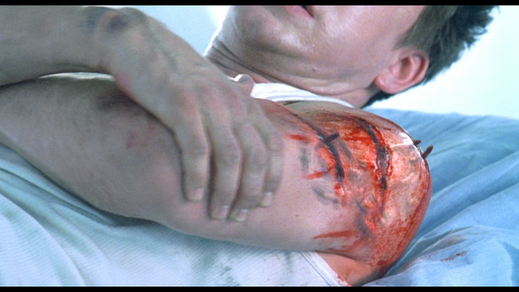
When Hive survivor Matt Addison was scratched by a heavily mutated Licker, he became infected with the T-virus. His entire body went through unimaginable pain as the virus mutated his cells, except for his arm which went numb below the scratches. He convulsed as small, thin tentacles emerged from the three scratches on his arm.
Matt responded differently than expected to the virus. When he was shown to have promise as a compatible host, he was put in the Nemesis Program along with Alice Abernathy. His DNA was particularly susceptible to the modifications required for the Nemesis Program. Matt was somewhat compatible with T-virus infection in general, like Alice or Wesker (Apocalypse novelization).
Umbrella both observed Matt’s mutation process (taking blood and even urine tests) and influenced it with genetic and cybernetic augmentations, along with some kind of mental programing. Matt was kept awake and aware throughout this process, although he was seemingly paralyzed.
Within hours Matt had become the first success in the Nemesis Program. He was officially designated Nemesis version 1.0.0.
Matt responded differently than expected to the virus. When he was shown to have promise as a compatible host, he was put in the Nemesis Program along with Alice Abernathy. His DNA was particularly susceptible to the modifications required for the Nemesis Program. Matt was somewhat compatible with T-virus infection in general, like Alice or Wesker (Apocalypse novelization).
Umbrella both observed Matt’s mutation process (taking blood and even urine tests) and influenced it with genetic and cybernetic augmentations, along with some kind of mental programing. Matt was kept awake and aware throughout this process, although he was seemingly paralyzed.
Within hours Matt had become the first success in the Nemesis Program. He was officially designated Nemesis version 1.0.0.
Once Matt was transformed into Nemesis, he no longer resembled his former self due to “his cellular structure breaking down”. Despite this he was said to be internally identical to Alice after her experimentations. While he had DNA that was generally compatible with the T-virus it was not as perfectly compatible as Alice’s was, and so excessive mutations were not entirely avoided.
It is unknown if his being scratched by a Licker caused him to undergo live mutation or if his unique DNA caused him to survive the symptoms that normally lead to the creation of Undead. It could be that the fact he was not injected like Alice or Wesker was why he lost his human form.
Matt, as Nemesis, was eight feet tall, hairless (including a lack of eyebrows, which could have simply been shaved prior to surgery), and had yellowish colored skin. His muscles were larger than even the most muscular human. His size and muscles were likely due to a combination of the virus causing the overdevelopment of muscle and bone, like Lickers, as well as Umbrella modifications. Unlike Lickers his bones did not become deformed.
All of the internal organs of Nemesis remained the same in appearance, besides an increase in size. He retained his genitalia following his transformation.
It is unknown if his being scratched by a Licker caused him to undergo live mutation or if his unique DNA caused him to survive the symptoms that normally lead to the creation of Undead. It could be that the fact he was not injected like Alice or Wesker was why he lost his human form.
Matt, as Nemesis, was eight feet tall, hairless (including a lack of eyebrows, which could have simply been shaved prior to surgery), and had yellowish colored skin. His muscles were larger than even the most muscular human. His size and muscles were likely due to a combination of the virus causing the overdevelopment of muscle and bone, like Lickers, as well as Umbrella modifications. Unlike Lickers his bones did not become deformed.
All of the internal organs of Nemesis remained the same in appearance, besides an increase in size. He retained his genitalia following his transformation.
The staples alongside the face of Nemesis were likely the result of him having implants in his skull, with a side effect being the disfigurement of the face. Staples went from the right side of his face to the side and up across the eye and over the head, going over the top, indicating his skull was cracked open. Matt’s face being removed along this line is actually seen in a flashback in Apocalypse. Other cuts were visible on Nemesis’ face which had already sealed; yet scars were left behind, perhaps as a result of the wounds being inflicted before his regenerative abilities were at their peak efficiency.
Nemesis had no lips or nose, which were either removed when his face was ripped apart during surgery or degraded by the virus. His exposed gums were purple, and his teeth were enlarged. His outer ears were removed, leaving open holes. His single exposed eye retained its color and appearance. The flesh of his body was torn, likely from expanded muscles, like the Licker. Also like the Licker his jaw was squared in shape.
Tentacles (or wires, going by the novelization) wormed their way throughout his skin, likely the same that began to grow from the scratch on his arm. These tentacles seemed to be rigid and incapable of movement.
Besides biological mutations, Umbrella also performed cybernetic and electronic enhancements on Nemesis. The modifications the previous prisoners rejected may have been due to their immune systems rejecting the cybernetics implanted into the brains and other parts.
Nemesis had many pipes and wires running throughout his body, and tubes feeding a variety of stimulants into his bloodstream (Apocalypse novelization). The stimulants and cybernetics increased the already unthinkable strength of Nemesis, allowing him to walk through solid walls and tear steel with ease. He could even lift a seven-foot-long rocket launcher in one hand and a railgun large enough to fit as a helicopter attachment on the other, and fire both simultaneously without suffering any recoil.
Nemesis had many pipes and wires running throughout his body, and tubes feeding a variety of stimulants into his bloodstream (Apocalypse novelization). The stimulants and cybernetics increased the already unthinkable strength of Nemesis, allowing him to walk through solid walls and tear steel with ease. He could even lift a seven-foot-long rocket launcher in one hand and a railgun large enough to fit as a helicopter attachment on the other, and fire both simultaneously without suffering any recoil.
Nemesis was also surprisingly agile and quick. While he was not as fast as Alice was due to his size and weight, his longer legs gave him longer strides when he ran. He was able to jump extreme heights and leap over tall obstacles like fences and even rooftops. When landing his weight was so great as to cave-in cars and to crack pavement. Nemesis was also surprisingly stealthy for his size. On one occasion he perfectly hid himself from plain sight by clinging to the shadows.
Nemesis’ implants also altered his senses. His sense of sight, smell, hearing, and touch were all vastly improved, while his sense of taste was deadened to avoid distractions in field work (Apocalypse novelization).
Nemesis was also surprisingly agile and quick. While he was not as fast as Alice was due to his size and weight, his longer legs gave him longer strides when he ran. He was able to jump extreme heights and leap over tall obstacles like fences and even rooftops. When landing his weight was so great as to cave-in cars and to crack pavement. Nemesis was also surprisingly stealthy for his size. On one occasion he perfectly hid himself from plain sight by clinging to the shadows.
Nemesis’ implants also altered his senses. His sense of sight, smell, hearing, and touch were all vastly improved, while his sense of taste was deadened to avoid distractions in field work (Apocalypse novelization).
The left image is concept art by Rob McCallum. The right image was scanned by RELive from the Biohazard 2 Movie Data File.
Nemesis could see the same spectrum of textures and color as humans, in addition to being able to see in thermal and ultraviolet radiation. By using thermal vision Nemesis could not only pick-up targets from behind cover and through fog or other debris, but he could also easily distinguish between live targets and Undead (the latter of which lacked body heat). Any ultraviolet radiation present in an environment was enough for Nemesis to make out shapes (Apocalypse novelization). Nemesis could also make out details at long ranges with the help of a magnifying functionality.
Nemesis’ hearing was so great that he could hear the sound of a sniper reloading from afar off, pick up distant conversations, and could even find the source of a shooter by triangulating the sound of the gunshot with the trajectories of the bullets (Apocalypse novelization).
These enhancements were benefited by what seemed to be a computer either built into Nemesis’ head or wirelessly connected to him. His vision even had a heads-up-display (HUD) as if it were a computer screen, and distant Umbrella operatives could see his POV from a plasma-screen monitor. From here the screen user could even make a facial ID on targets within Nemesis’ vision. The screen displaying Nemesis’ POV was blue tinted with a stream of data flowing on one side. It is unknown if this was what Nemesis actually saw or if it is simply how Umbrella saw his vision on their monitors.
His hearing was also piped through speakers, and his vital signs were displayed on another screen. Another monitor had a keyboard that fed directly into his cerebral cortex (Apocalypse novelization). By typing commands into the keyboard, orders would appear on Nemesis’ HUD. The HUD also displayed information such as ammunition count and what bodily and cybernetic systems were still active. According to the HUD, Nemesis carried 5000 railgun bullets in the gun itself (also indicated on a screen on the gun itself) and 6 rockets. The HUD also displayed what threat level his targets posed. His targets were numbered on the HUD and categorized by what occupation they held as was relevant (for example, S.T.A.R.S. and civilians). He could determine what guns his targets had along with how many bullets they could carry. His overall body integrity was summarized by a percentile on his HUD.
Nemesis was also said to have had “killer instincts”, which were said to be the same as those possessed by Alice Abernathy. This could imply Nemesis also had mind powers, or simply be referring to his combined senses being great enough to enhance his overall instincts.
Nemesis’ metabolism was “supercharged”, likely from both the virus and his modifications, both biological and electronic. He could quickly regenerate and heal from any wound. Not only this, but his body was so strong that a shotgun hit to the chest did “point-zero-one percent damage” and felt like “a minor tap on the ribs”. After being showered in automatic fire by twelve S.T.A.R.S. members, his overall health percentage only went down to around 96.1%, and climbed back up by the second, while his analyzed threat level of the situation never went above minimal. When he confronted Alice, the threat was raised to moderate. His vitality was accentuated by his seemingly bulletproof coat that Umbrella wrapped him in.
Nemesis retained all of his intelligence, but once awakened had no memories of his own identity, personality, or goals despite his name (“Nemesis”) and his master (“the Umbrella Corporation”, and in particular Major Timothy Cain). Nemesis did however know the inner workings of his own parts, could identify a hospital room, knew how to operate firearms, could create a makeshift sword with a piece of metal, and had knowledge of other things “Nemesis” had no experiences with. These could be remnants of Matt Addison’s memories not removed by Umbrella, implanted memories (like those which were implanted into Umbrella-made clones; Retribution), or a result of Nemesis’ link to Umbrella computers. It may be that Nemesis was entirely controlled by an implanted AI that bypassed the brain. Even if this was not so, he did have a “memory core” that may not have been organic, implying at least some cybernetic changes to the brain which affected his behavior (Apocalypse novelization). Nemesis likely had a “control unit” implanted into the base of his skull, like that used on the Cerberus bioweapons (The Final Chapter novelization).
Nemesis’ mind was very technical, and he followed orders only in the most literal sense. He would only attack targets that he was ordered to attack, as well as anything his computer designated a threat to him. Nemesis was able to navigate environments he had no memory of. He could also receive some orders without any information appearing on the HUD, which may indicate that the HUD display was more for the benefit of those viewing his POV. Orders were rather directly fed into his neo cortex, allowing Nemesis to follow commands as if they were his own instincts. Nemesis was also able to be controlled through the verbal commands of Cain.
While Nemesis’ mentality was comparable to a machine running on specific programing, he was also ferocious. He growled and roared instead of speaking, showing aggression towards those he was sent after. It may be the natural aggression of T-virus mutants was redirected towards the enemies of Umbrella, rather than being suppressed. Despite this aggression he showed no inclination towards feeding on uninfected flesh like his infected brethren, suggesting Umbrella managed to eliminate this instinct or that Matt’s unique DNA allowed him to overcome it, like Alice.
Nemesis did speak on one occasion, although the only thing he said was “S.T.A.R.S.” (his targets). Why Nemesis said this at this time is unknown, although it could have been him venting his excitement after killing his quarry, or even a declaration of victory. His mutated vocal cords caused his voice to deepen. His voice was raspy and made gurgling noises.
While Matt Addison’s memories, sense of self, and personality were supposed to be wiped away, Nemesis did retain a remnant of Matt’s mind. This was referred to as what was left after Umbrella “subsumed Matt’s personality” using some kind of “programming”. Nemesis "himself" even speculated this may have been a “phantom program” in his memory core. This remnant manifested itself as a separate personality that coexisted with the Nemesis mind. While it could sense everything Nemesis did (including the cybernetic senses), it had no control over his body. Nemesis acknowledged but did not recognize the Matt personality (Apocalypse novelization). If the T-virus was an intelligent creature (see “T-virus Parasite Theory”), it may be that Umbrella was controlling the parasitic intelligence formed in the mind of Nemesis while Matt’s personality was weakened and left a prisoner in his own body (supported by the later novelizations claiming that Undead minds still possessed the remnants of the hosts’ consciousnesses, who were “trapped” like Matt was).
Nemesis was prematurely awakened from Raccoon City Hospital remotely by Cain for the purpose of testing his abilities in the field, taking advantage of the ongoing outbreak to do so. His primary directive was to combat Alice in order to determine the extent of the abilities of both subjects while also determining which one was superior. His secondary objective was to kill the remainder of the police unit S.T.A.R.S., whose elite combat abilities made them worthy combatants for data collection. Umbrella air-dropped his guns for him to recover for this purpose.
Nemesis managed to kill all the surviving members of S.T.A.R.S. (save for Jill Valentine) before he was even “fully activated”. This activation could refer to his cybernetic parts not being fully enabled or to the residual effects of his sedation. Upon sighting Alice, Nemesis was fully activated and the two engaged in combat.
Over time Matt was eventually able to wear down the mental resistance of the Nemesis personality by forcing his memories onto the creature (Apocalypse novelization). He finally overcame the conditioning by making Nemesis become aware of its own programming, long enough to allow Alice to defeat him in battle, at which point Alice recognized him. Injured and abandoned by Umbrella, Matt was able to regain control of his body. Nemesis/Matt fought off Umbrella paramilitary with Alice before being pinned to the ground by a crashing helicopter. Stuck under the wreckage, Nemesis was killed when Raccoon City was nuked shortly thereafter.
Cain considered Nemesis an evolutionary dead-end due to his grotesque appearance and inferior viability when compared to Alice; but Cain did consider him a superior soldier to Alice due to its lack of individuality. Isaacs considered the project a failure and attributed the faults seen in Nemesis to it being deployed too early (Apocalypse and Extinction novelizations). Despite this, Isaacs seemed to use the Nemesis trial data in his further experiments on Project: Alice.
Axe Man (alternatively called “Axeman”, “Axe Undead”, and “Executioner”) was a special type of mutant encountered several years into the T-virus pandemic. Several of these monsters were created by the Umbrella Corporation. They were designed at Umbrella Prime for the purpose of being sold as bioweapons, but after the T-Virus Pandemic started they were released into the wild by Red Queen to assist in the destruction of mankind.
Axe Men appeared to be giant humanoids with enough intelligence to use weapons and the motor control to run. If Axe Men were Undead (which they were identified as in the screenplay for Afterlife), then brain activity was either enhanced like Super Undead or more of the brain was preserved when the host died. Axe Men could have been administered the same serum used to create Super Undead, or Las Plagas. If Axe Men were live hosts, then they appear to have been similar to Nemesis, but probably without the extensive cybernetic implants. Axe Men could even have been predecessors to Nemesis, or cheaper successors that failed to acquire the abilities that Nemesis possessed due to Matt Adisson’s unique DNA.

The flesh of the Axe Men was impaled and stabbed with what appeared to be metal rods. These could have been self-inflicted, indicating insanity and even sadomasochism, or they could be the result of Umbrella testing the pain tolerance of the Axe Men. The latter could indicate that they were actually prototypes. The wounds could also simply have been cosmetic in nature, to invoke fear in their targets. This reason could also explain why the weapons they wielded were makeshift axes made with guillotine blades. Axe men also carried hooks. One Axe Man’s smock was made from human skin. This also was likely made by the Axe Man itself.
On a computer screen display running data on the Axe Men at Umbrella Prime, an Axe Man was shown without any spikes in its body. This could mean Umbrella didn’t inflict these wounds on them, which would support the idea that the wounds were self-inflicted. The Axe Man displayed also appeared to be wearing what looked like goggles. These goggles may very well have been to display a HUD for the Axe Men to receive orders, directions, and combat information, similar to the HUDs used for Nemesis, Alice, and Jill.
The skin of Axe Men was discolored and pale, like other hosts. In addition to their mutilations Axe Men also had surgical scars like those on Nemesis. Their faces were covered by executioner hoods, and so any potential facial deformities, as well as their “goggles”, were not visible. This could have been another cosmetic choice, or perhaps the Axe Men retained enough intelligence and memory to be bothered by their own inhuman appearance. They also wore rags and chains. One Axe Man appeared to have long hair underneath its hood, visible when it was knocked over and began to pull itself up.
All Axe Men seen appeared to have been based on a human host with dark skin. Besides simply being a coincidence or a cosmetic choice, this could imply all Axe Men were cloned from a single successful experiment. It may be that this was how Umbrella planned to reproduce Nemesis if it was successful after the trial in Raccoon City, just as Alice was cloned in Nevada by the remains of the Nemesis Program staff (namely Isaacs). The human hosts they were based on could alternatively have been all cloned from a single individual.
Some Axe Men appeared to have extended bellies, which harms the idea of them all being cloned from a single host. It may be these specimens simply fed on a large amount of uninfected flesh. The idea that Axe Men ate the uninfected like other mutants created by the T-virus is supported by a line from the Retribution novelization, where the Axe Men were described as being driven by a desire for human flesh. Their heads being covered is an obstacle to this idea, yet they could have simply removed their hoods to feed.
On a computer screen display running data on the Axe Men at Umbrella Prime, an Axe Man was shown without any spikes in its body. This could mean Umbrella didn’t inflict these wounds on them, which would support the idea that the wounds were self-inflicted. The Axe Man displayed also appeared to be wearing what looked like goggles. These goggles may very well have been to display a HUD for the Axe Men to receive orders, directions, and combat information, similar to the HUDs used for Nemesis, Alice, and Jill.
The skin of Axe Men was discolored and pale, like other hosts. In addition to their mutilations Axe Men also had surgical scars like those on Nemesis. Their faces were covered by executioner hoods, and so any potential facial deformities, as well as their “goggles”, were not visible. This could have been another cosmetic choice, or perhaps the Axe Men retained enough intelligence and memory to be bothered by their own inhuman appearance. They also wore rags and chains. One Axe Man appeared to have long hair underneath its hood, visible when it was knocked over and began to pull itself up.
All Axe Men seen appeared to have been based on a human host with dark skin. Besides simply being a coincidence or a cosmetic choice, this could imply all Axe Men were cloned from a single successful experiment. It may be that this was how Umbrella planned to reproduce Nemesis if it was successful after the trial in Raccoon City, just as Alice was cloned in Nevada by the remains of the Nemesis Program staff (namely Isaacs). The human hosts they were based on could alternatively have been all cloned from a single individual.
Some Axe Men appeared to have extended bellies, which harms the idea of them all being cloned from a single host. It may be these specimens simply fed on a large amount of uninfected flesh. The idea that Axe Men ate the uninfected like other mutants created by the T-virus is supported by a line from the Retribution novelization, where the Axe Men were described as being driven by a desire for human flesh. Their heads being covered is an obstacle to this idea, yet they could have simply removed their hoods to feed.
The exact height of an Axe Man seems to somewhat vary between the size of two humans stacked on top of each other, or three. This could indicate that there were different types with different sizes. The reasons for these different types could have been the same as the reasons listed above for the Uber-Lickers that varied in size – individuals who were in different stages of development, individuals that reacted differently to their modifications, or individuals that were designed differently. Taking the Uber-Licker comparison even further, Axe Men could even have been Undead that went through the same modifications that the Uber-Lickers underwent (making them “Uber-Undead”).
While an Axe Man would often simply drag its axe behind it, they could also run at impressive, surprising speeds while holding it upright with both arms. This demonstrated their incredible strength. They could swing their axes with such force as to nearly chop a bus in half and could tear humans apart with extremely little effort. Axe Men could even hurl their axes across extreme distances.
Axe Men could survive being shot many times in the head with handguns (including machine pistols), while a shotgun at point-blank range could destroy the head and kill them. This could mean the skull was strengthened enough to repel some amount of ballistic damage. Some Axe Man had spikes impaling their heads as well, which may simply mean the parts of the brain required to survive, like the brain stem, were extremely small and hard to get to. Axe Men did react to being shot at to a small degree, but bullets seemed to be more of an irritant than anything else, similar to Uber-Lickers. Enough trauma could knock an Axe Man over and even seemingly knock it unconscious.
Axe Men were intelligent enough to possibly clothe themselves, display sadomasochism, and use tools, but none of them were ever depicted speaking. Instead, they preferred to growl, grunt, and roar, with a voice far lower than that of a normal human. One Axe Man lifted its axe and made a sort of battle cry before chasing Alice.
While an Axe Man would often simply drag its axe behind it, they could also run at impressive, surprising speeds while holding it upright with both arms. This demonstrated their incredible strength. They could swing their axes with such force as to nearly chop a bus in half and could tear humans apart with extremely little effort. Axe Men could even hurl their axes across extreme distances.
Axe Men could survive being shot many times in the head with handguns (including machine pistols), while a shotgun at point-blank range could destroy the head and kill them. This could mean the skull was strengthened enough to repel some amount of ballistic damage. Some Axe Man had spikes impaling their heads as well, which may simply mean the parts of the brain required to survive, like the brain stem, were extremely small and hard to get to. Axe Men did react to being shot at to a small degree, but bullets seemed to be more of an irritant than anything else, similar to Uber-Lickers. Enough trauma could knock an Axe Man over and even seemingly knock it unconscious.
Axe Men were intelligent enough to possibly clothe themselves, display sadomasochism, and use tools, but none of them were ever depicted speaking. Instead, they preferred to growl, grunt, and roar, with a voice far lower than that of a normal human. One Axe Man lifted its axe and made a sort of battle cry before chasing Alice.
Concept art by Rob McCallum
In an original screenplay for Afterlife, the Axe Man was simply described as being an especially intelligent Undead. It was said to be based on a large host who carried an axe due to it being “the remnants of his life/work before the apocalypse”. The Axe Man was quiet and calculating in this depiction, standing patiently by a closed gate until the opportunity to bypass it presented itself. It did not seem to be any more resilient than a normal Undead but was able to use the head of its axe to shield itself from gunfire. It did not seem to wear a hood as its eyes were said to glitter in the light of torch fire. It not only used its axe as a weapon but threw punches capable of sending adult humans sprawling through the air as well. The idea that the Axe Man was simply a unique Undead individual was not used, as in Retribution it was shown to be a bioweapon that was produced by Umbrella.
Axe Men were an adaption of the Executioner Majini from Resident Evil 5, yet they took the same name as the alter ego of Al Lester from Resident Evil Outbreak: File #2 - “Axe Man”.
Axe Men were an adaption of the Executioner Majini from Resident Evil 5, yet they took the same name as the alter ego of Al Lester from Resident Evil Outbreak: File #2 - “Axe Man”.
Mentioned in passing in both the Retribution screenplay and novelization, Giant Spiders were described as being T-virus mutants. They were first encountered sometime before 2012 and were among the millions of creatures besieging the White House. Like the other monsters in the area, they were driven by a hunger for uninfected flesh. They were also likely among those creatures controlled by avatar implants and absorbed by the Melange (The Final Chapter novelization).
It is unknown if Giant Spiders were the result of normal spiders becoming infected with the T-virus in the wild or if they were bioweapons created and released by Umbrella. Regardless, they were likely made possible by the tissue expansion symptom and raw mutagenic potential of the virus. How large they actually were is also unknown, but if they were meant to be an adaption of the Giant Spiders from the game series, they were likely roughly human-sized.
Infectors were flying insect/human-like creatures developed by Umbrella with the T-virus in order to counteract humanity’s aerial advantage over the Undead. An especially large number of Infectors were used in the siege of the White House. As Alice had never seen them before (Retribution novelization), and since their presence was meant to signal an approaching climax to the human race (Retribution featurette), it would seem that Infectors were created late into the pandemic.
Infectors could have been the result of splicing human DNA with a flying insect. The Hive was previously said to host splicing experiments with animals. The vitality granted in hosts by the T-virus may have allowed human hosts to survive the introduction of foreign genes without rejecting them or going through an autoimmune response. The new genes could have been from a butterfly, a moth, or even a bat.
Many Infectors differed in size, similar to how individual Axe Men and Uber-Lickers had variable sizes, but all of them were very large. The largest known Infectors were bigger than SUVs. The different sizes could have been due to a difference in age, or they could have been different variants. The smaller Infectors had glowing red eyes (which could be something that only manifested at night), and their four red wings resembled the Umbrella Corporation logo. Larger Infectors had yellowish/brownish, leathery skin. If smaller Infectors were younger specimens, then they may have shed their skin or entered a chrysalid before they developed adult-colored hides.
Many Infectors differed in size, similar to how individual Axe Men and Uber-Lickers had variable sizes, but all of them were very large. The largest known Infectors were bigger than SUVs. The different sizes could have been due to a difference in age, or they could have been different variants. The smaller Infectors had glowing red eyes (which could be something that only manifested at night), and their four red wings resembled the Umbrella Corporation logo. Larger Infectors had yellowish/brownish, leathery skin. If smaller Infectors were younger specimens, then they may have shed their skin or entered a chrysalid before they developed adult-colored hides.
Each Infector had a human head and an insect-like body. The head lacked a jaw, instead possessing two mandibles that were more rigid than those seen on Majini Undead. The mandibles did not necessarily make Infectors Undead, since Albert Wesker developed mandibles as well. Rather it could have been a mutation inherent to the T-virus, or simply another one of the Infector’s insect traits. An Infector’s head was tipped with backwards-facing horns or antennae. Their teeth were sharp. The body of an Infector was rough and marked by bumps.
The Infectors’ arms were transformed into wings. Each wing split off into two ends, creating a total of four wings on each Infector. The wings were covered in tears, which could have been the result of constant use without a regard to environmental hazards. Despite being thin these wings were strong enough to lift an Infector’s massive body and fly with incredible speed. They were capable of letting out an ear-piercing, almost bird-like screech. The screech created by a larger Infector was more distorted-sounding than that of a smaller type.
The Infectors’ arms were transformed into wings. Each wing split off into two ends, creating a total of four wings on each Infector. The wings were covered in tears, which could have been the result of constant use without a regard to environmental hazards. Despite being thin these wings were strong enough to lift an Infector’s massive body and fly with incredible speed. They were capable of letting out an ear-piercing, almost bird-like screech. The screech created by a larger Infector was more distorted-sounding than that of a smaller type.
The body of an Infector resembled an insect abdomen. It had no human legs and was instead flanked by eight insect limbs with sharp ends. While these legs were not large enough to hold up the body of a larger specimen, Infectors were capable of using their wings to prop themselves up while on the ground, similar to bat behavior. The wings of a grounded Infector could curl like insect legs, with sharp ends that touched the ground like feet.
The end of an Infector’s abdomen possessed a tail, which could have been a modified insect stinger. This tail ended in a large claw with three sharp digits. This claw was strong enough to tear apart humans and vehicles with ease, giving Infectors a deadly hit-and-run weapon. It could also be used to easily take out aircraft such as military helicopters. This demonstrates the efficiency of Infectors in fulfilling their designed purpose – to not only circumvent walls and fences but to take out the technological advantages possessed by humans. Infectors were also capable of sprouting three tentacles from the base of their tail/pelvis area. These tentacles had sharp ends and would thrash around and whip at ground targets as an Infector hovered over the ground or as it pursued prey.
The end of an Infector’s abdomen possessed a tail, which could have been a modified insect stinger. This tail ended in a large claw with three sharp digits. This claw was strong enough to tear apart humans and vehicles with ease, giving Infectors a deadly hit-and-run weapon. It could also be used to easily take out aircraft such as military helicopters. This demonstrates the efficiency of Infectors in fulfilling their designed purpose – to not only circumvent walls and fences but to take out the technological advantages possessed by humans. Infectors were also capable of sprouting three tentacles from the base of their tail/pelvis area. These tentacles had sharp ends and would thrash around and whip at ground targets as an Infector hovered over the ground or as it pursued prey.
Larger Infectors had extremely strong bodies. One Infector survived being buried in rubble (although it appeared to be unconscious), crashing through a concrete building (causing the structure to collapse), and being rammed by a SUV at full speed, before it was finally killed by a massive explosion blowing it to pieces.
In The Final Chapter novelization, Infectors had detachable, flechette-like spines that could be launched from their wings. They could use these spines from the air to shoot ground-based targets. These spines contained some sort of chemical with mutagenic properties - possibly a new strain of the virus. It may be the virus was placed there by Umbrella by engineering a cavity within the spines, since the virus it carried did not seem to be the same as the virus inside the Infectors’ cells. This new virus could be used to transform living organic matter into the Melange (see below). Infectors used by Dania Cardoza for this purpose obeyed her commands – either they were trainable, or they, like the hordes of Undead they transformed, were controlled using avatar implants. It is unknown if larger infectors possessed this ability – it is possible that the smaller type was specifically designed to create a Melange while the larger type was designed with brute force in mind.
Infectors were named in the novelization for The Final Chapter. Their names were in reference to their spine attack. Infectors were not named anywhere else. Infectors were an adaption of flying Plaga from Resident Evil 5 called Kipepeo.
This Melange art was commissioned by Lunar Indie Studios from Rachael Leone. Special thanks to Lunar Indie Studios for generously allowing this art to be used in this analysis and to the artist for making it. Check out the preview of the video featuring this art here.
The Melange was an experimental Umbrella bioweapon created using the chemical found in the detachable spines of Infectors. This chemical altered the bodies of infected creatures from various different species, and it is unknown if it would also work on uninfected biomatter (as pondered by Alice). The Melange had, as put by Albert Wesker, a “primal elegance” to it.
When the Infector chemical was used on a potential host, the organism would begin flailing wildly. The host flesh would expand and eventually break out in large, oozing pustules. The limbs of the host would expand, causing their bones to break. The broken bones would then fuse together in unnatural angles, and then break again as the body continued to expand. The pustules would continue to grow across the surface of the expanded flesh and would themselves expand into tentacles. The entire host would seemingly become a mound of individual tentacles, at least on the outside. Finally, the tentacles would fuse together into a solid surface, and the host would be left as a shapeless, amoeba-like blob of flesh.
If multiple hosts were infected by Infectors and were in close proximity to one another during their transformation, the pustule/tentacles would reach out and connect to the tentacles of other hosts. The separate hosts would meld together like liquid, and once the transformation finished, they would be left as a single organism – the Melange.
A Melange’s surface was normally featureless, and its hide was discolored and mottled. It was semi-viscous with spongy flesh. The inside of its body was filled with a grey gunk. It did not appear to have any vulnerable organs, or if it did then they were unreachable due to the tons of absorbent flesh surrounding them. While gunfire had almost no effect on the body of a Melange, explosions could blow off chunks of it and fire could blacken its skin. But if a Melange was large enough these would have very little impact on the body as a whole, and a Melange could rapidly heal from almost any damage as quickly as it was made. Its body was not particularly flammable (at least its skin was not, although its insides were described as possibly being more susceptible to fire), and only the most extreme, widespread fires could set it ablaze.
A Melange could change its tissue on the fly in combat. It could sprout tentacles from its body like those seen while it initially developed, which it used to bend tank barrels and throw helicopters out of the sky (displaying a surprising amount of intelligence in doing so). The main purpose of these tentacles was to grab potential sources of food and then pull them into the main body. Besides being strong enough to bend steel, these tentacles were also incredibly fast. They could both shoot out faster than a person without superhuman speed could dodge them and reel them in before they were capable of breaking free. The tentacles were spongy and impossible to get a firm grip on by hand but could be severed by using a sharp blade (at least after its overall integrity was already compromised).
The tentacles created by a Melange were capable of grabbing prey with extreme accuracy and could seek prey out from within vehicles. This would imply the Melange had excellent senses, achieved through specialized, light sensitive cells on its skin or even through psychokinetic powers. A Melange could also detect dangers to itself and would react to a person lifting an arm to chop off a tentacle by grabbing the arm by the wrist. This, in addition to its combat adaptability, implies the Melange was intelligent.
A Melange devoured its prey by forming makeshift “mouths” around the tentacles that pulled in prey, which would disappear after swallowing the prey whole. They acted only as an entrance point for food and lacked any sort of teeth for chewing. These mouths could, however, scream when the Melange was heavily damaged – indicating it had both pain receptors and vocal cords or some other organs capable of producing sound. The biological purpose for a Melange screaming can only be assumed. Since developing Melanges tended to combine into a single organism, it probably was not a method used for communication (as there would be no other Melanges to communicate with). It may have been a leftover trait inherited from the humanoid hosts used as a basis for Melange development, or it could imply the base hosts were still individually functioning to some extent and simply cooperated with one another inside of the fleshy mass. Either of these explanations could also account for Melange intelligence. It could even be that Melange screaming was exclusively used when a Melange was burned, with the noise created actually being a symptom of air expulsion, which would be an attempt to cool itself and put out fires on its surface.
Once a Melange devoured prey, it is unknown exactly what happened. Alice theorized that human food may at first have been first suffocated within the fleshy mass, or digested alive, with both potential deaths being extremely slow and miserable. It is stated the substance making up Melange flesh may have been acidic, or the gray fluid they carry like blood may have been digestive acid. The latter would explain the foil stench of this internal fluid. A Melange would break down biological matter, like that of humans, into its base chemical components, which would be absorbed into the Melange. When a Melange dissolved, some half-digested body parts would be left behind. An injured Melange would attempt to devour undamaged biological material in order to aid in healing, which would imply it did eat in order to fuel its continued growth, or at least to support its incredible metabolism.
Despite the overwhelming power a Melange possessed it was still experimental and had a number of faults. For one thing, it seemed either incapable of movement or severely limited in this regard. (a dying Melange did move to fill in a clearing in its mass, but this was speculated to just as likely be a result of its body breaking down and spreading out). The range of its tentacle attacks mostly made up for this.
A much more severe fault was that Melanges were biologically unstable. They could only maintain themselves for 15 minutes following their initial creation, after which point they would die. The tentacle-comprised flesh would lose cohesion and come apart while the already semi-viscous substance they were made of would begin to liquify, until all that was left was a lifeless sludge. After a short time even this sludge would evaporate until nothing remained, except for the stink.
This limitation could actually have been a safety precaution to ensure a Melange did not become unstoppable (although the airborne Anti-Virus developed by Umbrella would probably destroy it, so the risk of this was minimal for Umbrella). A Melange could wipe out all enemies in a location, devour their bodies, dissolve, and then leave the location completely empty for the victors who used the Melange to occupy. This, as noted by Alice, made it a very effective bioweapon.
The origins of the chemical that created the Melange are unknown. It may have been:
1. An alternative stain of the T-virus. The tendrils that fuse to create the Melange flesh could actually have been the virus/T-Cell itself, grown massive, similar to Uroboros pustules from Resident Evil 5. They could also have been related to the tentacle growths seen in many T-virus mutants, like Nemesis, Tyrant, and Wesker.
2. A bacterium or fungus engineered or infected with the virus. Some fungi actually begin their lifecycle as amoebas, and so the similarities of a Melange to the body of an amoeba could be more than a coincidence.
3. A parasitic creature, possibly a derivative of Las Plagas, which used the chemical carried by Infectors to incubate in similar to how Bad Rain injected herself with a solution with Las Plagas in it. Going by the “T-virus Parasite Theory”, a Melange could be seen as the same parasite formed by T-Cells inside the bodies of infected, explaining its intelligence and tentacles.
Dania Cardoza, an employee in Umbrella’s research and development department, used avatar implants to drive a vast army of monsters towards the White House. Then, once they were close enough, she ordered a swarm of Infectors to transform them all into a Melange (no humans were transformed, either because uninfected tissue was not susceptible to the Melange chemical, or because Cardoza wanted the human defenders to experience as much suffering as possible). Once the ground-based creatures were transformed the Infectors dove into the flesh and were absorbed themselves (whether or not this behavior was ordered or if it was an instinctual behavior for Infectors is unknown). This creature surrounded the White House defenders like a coiled serpent. It killed Ada Wong, Leon S. Kennedy, and the majority of the remaining White House defenders. Cardoza’s intent in this attack was to kill Albert Wesker and to take his place in the company. Wesker rescued Alice from Umbrella Prime in order to use her psychokinetic powers to defeat Cardoza. Alice brought down Cardoza‘s aircraft and then expanded the fire from the wreckage using her powers to cover the gigantic Melange in flame, burning it to near death. It opened a thousand mouths which all screamed in agony as it was devoured by flame. Its body thrashed and its tentacles flailed wildly, and its flesh gave off a sickening stench of diseased meat. As it died its efforts, strength, and senses became weaker and weaker, and its previously incredible aim became inaccurate. It held onto life long enough to reach its 15-minute limit, then dissolved.
When Cardoza unleashed her Melange it made no attempt to attack her aircraft. It may be that she was somehow able to control the Melange or camouflage her aircraft against it. It is also possible the Melange would not sense biological lifeforms from inside of vehicles and would only attack them if they first open fire on the Melange.
The name “melange”, or mélange, is French for “mixture”. Its game counterpart may be Uroboros Aheri from Resident Evil 5, although it also somewhat resembled Nyx from Resident Evil Outbreak: File #2. The Melange only appears in the novelization for The Final Chapter; the moment in which it appears is skipped over by the actual movie.




